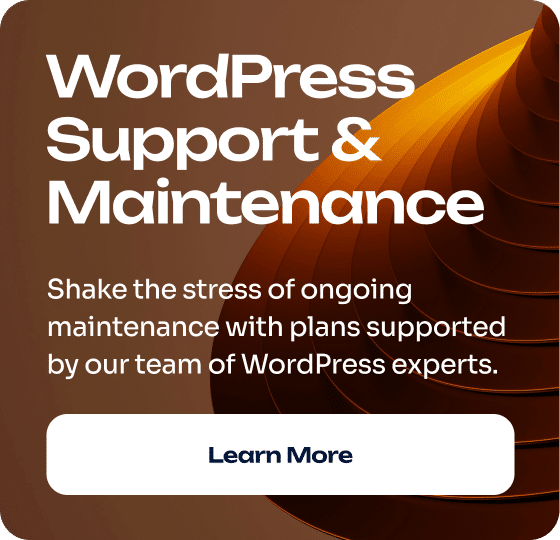How to Choose a Web Design Vendor Without Getting Burned
The web design space is a wild west. Completely unregulated. No licensing requirements. No certifications that mean anything.
You can call yourself a web designer with nothing more than a laptop and an internet connection. That’s it.
This creates a massive problem for business owners. How do you evaluate vendors when pricing ranges from $750 to $30,000 for what appears to be the same 10-page website? How do you know who’s qualified and who’s going to take your money and disappear?
I’ve been on thousands of sales calls over the past decade. I’ve seen every variation of this problem. Business owners who’ve been burned multiple times. HR teams comparing proposals that make no sense. Marketing managers trying to justify budgets to executives who don’t understand why websites cost what they do.
Here’s what you need to know to protect yourself and make a smart decision.
The Three Non-Negotiable Evaluation Criteria
Before you talk about price, timeline, or features, you need to establish whether a vendor is even qualified to do the work. Three things separate professionals from amateurs.
Portfolio Quality Tells You Everything
Look at their work. If you don’t love what you see, you’re in the wrong place.
The vendor’s own website and their portfolio are the most accurate prediction of what you’ll receive. This isn’t theory. This is what they actually produce when they control all the variables.
If they don’t have a portfolio, run. That’s not even a red flag. That’s a siren.
Would you hire a home builder who’s never shown you a house they built? Would you buy a car from a manufacturer that won’t show you their previous models? The comparison sounds extreme, but it’s accurate.
Pay attention to the quality of the work. Is it beautiful? Does it look modern? Does it match the caliber you expect for your own business? If their best work doesn’t impress you, their work for you won’t either.
A Defined Process Indicates Real Experience
Ask about their process. If they can’t articulate a clear workflow, they haven’t done this enough times to know what works.
Professional vendors operate with defined processes because they have to. There’s no way to run multiple projects simultaneously without a system. Creative chaos happens when you’re winging it every time.
Here’s what a proper process looks like:
Design phase first. Before anyone touches WordPress or writes a line of code, a designer creates mockups in Figma. You see exactly what the site will look like. You provide feedback. Revisions happen. You approve the final design.
Then development begins. A developer takes those approved designs and builds them according to best practices. Hand-coded. Responsive across all devices. Tested thoroughly.
Project management throughout. Someone coordinates between you, the designer, and the developer. Keeps everything on track. Manages timelines. Handles communication.
If a vendor says they’ll just start building in WordPress, that’s a disaster waiting to happen. Would you pour concrete for a house foundation without architectural plans? Would you do electrical work without a blueprint?
The same logic applies here. Design first, then build.
A vendor with a defined process has also iterated on that process. They’ve learned what works and what doesn’t. They’ve refined their approach based on dozens or hundreds of projects. That experience matters.
Communication During Courting Predicts Future Behavior
How a vendor treats you before they have your money tells you exactly how they’ll treat you after.
Are they responsive to your questions? Do they take time to understand your business? Are they attentive to details?
If they’re slow to respond during the sales process, they’ll be worse once they’re paid. If they seem distracted or disinterested now, that won’t improve later.
You need to feel confident this vendor can actually finish the project. Not just start it. Anyone can start projects. Finishing is the hard part.
Look at the team structure. Who’s doing the design? Who’s handling development? Who’s managing the project? Are these different people with specialized skills, or is one person claiming they can do everything?
One person cannot be a designer, developer, and project manager at the same level of expertise. Those are different skill sets. A great developer might be a terrible designer. A talented designer might know nothing about backend development.
The right people need to be wearing the right hats.
Understanding What Projects Actually Cost
Let’s do some basic math. A 10-page informational website requires real work.
Design phase: 20-30 hours minimum. The homepage alone takes a full day for an experienced designer. Interior pages take another day. Brand elements, typography, color systems, imagery selection. Client feedback and revisions. Exporting assets properly. Let’s call it 25 hours.
Development phase: 40-50 hours for a competent developer. Building out the approved designs. Making everything responsive. Testing across devices. Ensuring best practices. Adding functionality. Quality assurance. Call it 45 hours.
That’s 70 hours of professional work. Minimum.
Now apply an hourly rate. What should a professional with years of experience charge? Not $20. Not $50. Professionals in any trade charge $100-200+ per hour.
A plumber charges $150-200 to fix your toilet. An AC technician charges similar rates. These are skilled trades that require years of experience. Web design and development are the same.
When someone quotes you $1,500 for a custom website, the math doesn’t work. That’s $21 per hour for 70 hours of work. No experienced professional works for that rate.
Either they’re inexperienced and learning on your project, or they’re using shortcuts that will hurt you later.
The Starting vs. Finishing Problem
Anyone can promise you everything. Starting projects is easy. Finishing them is another story.
Vendors who operate without proper processes tend to over-promise. They commit to unrealistic timelines. They agree to scopes that don’t make sense. They quote prices that can’t possibly cover the actual work required.
Then reality hits. The project drags on. Communication slows down. Quality suffers. You’re stuck in an endless loop of revisions that never quite get you where you need to be.
Professional vendors know their capacity. They understand how long things actually take. They build buffer into timelines. They’re honest about what’s possible and what isn’t.
That honesty during the sales process might feel less exciting than someone promising the moon. But it’s what leads to successful outcomes.
Common Traps That Will Cost You
Three specific business models create problems for clients. If you encounter any of these, walk away.
Rented Websites Are a Disaster
Some vendors offer websites with no upfront cost. Just a monthly fee. Sounds appealing until you do the math.
I talked to someone recently paying $499 per month for their site. No upfront cost seemed like a good deal at the time.
Let’s calculate what that actually means. $499 per month is $5,988 per year. After three years, that’s $17,964 paid for a website.
Here’s the worst part: stop paying, and you have nothing. No website. No business asset. No way to move to another vendor. The site wasn’t yours. You were renting it.
Compare that to a traditional model. Pay $5,000 upfront for a properly designed and developed site. Pay $99-150 per month for managed hosting. That’s $1,188-1,800 per year for ongoing maintenance, security, backups, and updates.
After three years, you’ve spent $8,564-10,400 total. You own a business asset. If you ever want to switch vendors, you can. Your site goes with you.
The rented model costs double and leaves you with nothing.
Sites also get held hostage this way. Clients who want to switch vendors or hire someone to manage their ads discover they can’t access their own site. The original vendor won’t release it. Or they charge thousands of dollars to transfer ownership.
That’s not a business relationship. That’s a trap.
Templates Create Long-Term Problems
Theme Forest and similar marketplaces sell WordPress templates for $75 or less. Sounds like an easy shortcut.
Buy a template that looks close to what you want. Change the text. Swap the images. Launch the site. Total cost: a few hundred dollars plus some of your time.
Here’s what actually happens.
The template comes with a page builder you don’t fully understand. You can edit theme options, but anything beyond basic changes requires development knowledge you don’t have. The site looks generic because hundreds of other businesses are using the same template.
Then the real problems start.
WordPress releases a core update. Your template isn’t compatible. The site breaks. You reach out to the template developer for support. They’re gone. Template abandoned. No updates. No fixes.
You’re looking at a complete rebuild. Essentially overnight. Because you can’t move the site anywhere. The template was the site.
I’ve seen this multiple times. Clients come to us with template-based sites that collapsed. They thought they were saving money. Instead, they’re paying for two websites: the failed template and the professional rebuild.
Every lawyer website looks identical for this reason. Template-based services targeting specific industries. Same layouts. Same stock photos. Same generic content. Zero differentiation.
If you have a real business with real business needs, templates don’t work. They’re not scalable. They’re not maintainable. They’re not professional.
Overseas Outsourcing vs. Global Teams
Let me clarify something that confuses people. There’s a massive difference between outsourcing work and having a global team.
Outsourcing: You hire a vendor who doesn’t actually have developers. They take your project and find a random freelancer on a marketplace. Different person every time. No consistency. No accountability. The vendor is just a middleman marking up someone else’s work.
Global team: You have long-term employees located around the world. Same team members on every project. Defined roles. Years of working together. Location is irrelevant.
Our system administrator has 35 years of experience and happens to be in Europe. Our developers have been with us for years. Some are overseas. So what? They’re badasses at what they do.
I don’t care where someone lives. I care about work ethic, professionalism, and skill level.
The problem is outsourcing to random contractors who have no investment in your outcome. The solution is a real team where everyone knows their role and wears the right hat.
A designer shouldn’t be doing development work. A developer shouldn’t be doing design. A project manager shouldn’t be writing code. When you hire a vendor, you’re hiring their entire team. Make sure that team exists and has the right structure.
Protecting Your Investment
Getting the project done right is half the battle. Protecting what you’ve built is the other half.
You Must Own Your Domain Name
This is non-negotiable. The domain name must be registered in your name. In your account. Under your control.
I’ve been part of domain recovery efforts. They’re nightmares. Expensive. Time-consuming. Often unsuccessful.
Someone gains access to your domain registrar account because you didn’t enable two-factor authentication. They transfer the domain out. Point it somewhere else. Demand ransom.
One Shopify brand I know lost their domain this way. Real business. Real revenue. Domain got hijacked. The ransom demand was $50,000. They never got it back. Had to change their entire domain name. New brand. New email addresses. Years of SEO value gone.
All because they weren’t paying attention to fundamentals.
If a vendor tells you they need to own your domain, or they have to own it for technical reasons, that’s nonsense. Walk away. There is zero legitimate reason for a vendor to own your domain name.
Know Where Everything Lives
Most business owners can’t answer basic questions about their website. Where is it hosted? Who owns the domain? How do you access the backend? What email system are you using?
Get a piece of paper. Write down these questions. Ask your current vendor for answers:
- Where is the domain registered and who is the account owner?
- Where is the site hosted and what are the login credentials?
- What email system do we use and who controls it?
- How do I access the backend of the website?
- Is the hosting account in my name or yours?
These aren’t technical questions. These are ownership questions. You should know this information.
Better to find out now when there’s no emergency than to discover you don’t have answers when your site is down and you can’t reach your vendor.
I call this digital trauma. So many business owners have been burned by previous vendors that they’re gun-shy about the entire process. They’ve paid for sites they couldn’t access. They’ve lost control of their domains. They’ve been held hostage for data.
When you work with a professional vendor, transitions should be easy. If you decide to leave, they help you move. No hostage situations. No ransom demands. You own your business assets.
We manage hundreds of sites. They’re all in our ecosystem for management purposes, but clients own everything. Full admin access. Their data. Their domain. Their hosting account.
That’s how it should work.
The Done With You Model
You should have access to everything. So should your vendor. Both parties need admin credentials.
Most clients don’t want to deal with technical details. That’s why they hire professionals. But the option to access everything needs to exist.
Security updates, core updates, plugin updates, PHP version management, backups, malware scanning—all of that should be handled by professionals. You’re paying for that expertise.
But if you ever want to make a change yourself, or hire someone else to do specific work, you can. No permission needed. No gates. No restrictions.
When Professional Services Make Sense
Not every business needs a professional web design vendor. Some situations call for DIY solutions.
You Need Revenue First
If you’re an unfunded startup with no current revenue, you’re probably not ready for professional services.
The cost of proper design and development won’t make sense for your situation. You need to validate your business model first. Get some customers. Generate revenue. Prove the concept works.
Use Wix or Squarespace. Roll up your sleeves. Spend a weekend with a glass of wine and a family member helping you. Create a business card site. Get something online.
That’s fine for what you need right now.
Once you have revenue, once you’re spending money on paid advertising, once you need conversion tracking and optimization—then professional services become worth the investment.
Real Business Needs Justify Investment
If you’re spending hundreds of dollars per day on paid traffic, the cost of a professional website pays for itself in days.
If you have serious product margins and real business outcomes depend on your website performing well, cutting corners doesn’t make sense.
A properly designed landing page with good conversion rates directly impacts revenue. If 50% of visitors are booking calls or taking your desired action, that’s extremely valuable. Worth protecting. Worth investing in.
But if you don’t care who visits your site, if you’re not tracking conversions, if you’re not spending on paid media—then you probably don’t need a professional site. You need a business card online. Different requirements entirely.
Hidden Costs of Bad Solutions
The $1,500 website that sounds appealing often ends up costing $20,000 in the long run.
Not just the literal cost of rebuilding when it fails. The opportunity cost of lost leads. Poor user experience that drives potential customers away. Ranking for nothing because of technical SEO issues. Hours of your time trying to fix problems you don’t understand.
Template sites often duplicate content across multiple businesses. The same service offering templates to thousands of users. Same content. Same structure. Harmful to SEO because search engines see it as duplicate content across domains.
You spend months or years building traffic to a site that can’t convert because the user experience is terrible. Forms don’t work properly on mobile. Pages load slowly. Navigation is confusing. Design looks dated.
How much revenue did you lose during that time? How many potential customers visited and left?
That’s the real cost.
What You’re Actually Paying For
Professional services include things you might not consider.
Collective experience matters. A team with 100+ years of combined experience has seen every possible scenario. They know what works. They know what fails. They’ve made mistakes on someone else’s projects and learned from them.
You’re not paying for someone to learn on your dime.
Managed hosting from a professional vendor costs more than big box retailers. Maybe $99 per month instead of $30-40 doing it yourself. But you’re not just paying for server space.
You’re paying for someone to monitor your site. Handle core updates. Update themes and plugins properly. Manage PHP versions. Run security scans. Set up backups that actually work. Fix issues before they become emergencies.
The cost of the hosting itself, SSL certificates, premium plugin licenses, and infrastructure is already $30-40 per month. The additional $60-70 gets you professional oversight. Someone who knows what they’re doing. Someone who will respond when something breaks.
Compare that to doing it yourself. No idea what you’re doing. Spending hours troubleshooting. Site goes down and you don’t know why. Updates break things. Security vulnerabilities you don’t catch.
What’s your time worth? What’s the cost of your site being down for a day?
Industry Realities You Need to Understand
Web design is a professional trade. Just like plumbing, electrical work, accounting, or medicine. Years of experience matter. Expertise has value.
You wouldn’t perform your own surgery because you watched YouTube videos. You wouldn’t rewire your house because you read a few articles. You wouldn’t represent yourself in court because you found a legal template online.
The same logic applies to web design and development.
Can you technically use DIY website builders? Yes. Will the result be professional? No. Will it meet business needs for conversion optimization, technical SEO, and user experience? Unlikely.
Template-based solutions exist because fledgling designers need a starting point. They can’t afford to pay for proper design skills yet. They don’t know how to code. Templates let them deliver something.
That’s fine for their business model. It’s not fine for yours if you have real revenue at stake.
The Professional Comparison
An AC technician charges $150-200 per hour. They come to your house in the summer when it’s 110 degrees and your air conditioning broke. You pay them whatever they ask because they’re solving an immediate problem with specialized knowledge.
A plumber charges similar rates. Years of experience. Specialized skills. Emergency availability.
Web design professionals charge similar rates. Not because web design is an emergency. But because the expertise and experience have value.
If a project takes 70 hours and professionals charge $100-150 per hour, the math is straightforward. That’s $7,000-10,500 for the labor alone. Not counting tools, infrastructure, project management, or overhead.
A $1,500 quote doesn’t make sense. The numbers don’t work. Either the vendor is inexperienced and charging below market because they don’t know better, or they’re using shortcuts that will hurt you.
When to Walk Away
If someone offers you a custom website for $1,500-2,000, be extremely cautious. The math doesn’t support that pricing for custom work.
If a vendor can’t show you a portfolio, walk away immediately.
If they can’t articulate a clear process, that’s a red flag.
If they say they need to own your domain, run.
If they’re unresponsive during the sales process, imagine how bad communication will be later.
Trust your instincts. If something feels off, it probably is. This is an unregulated industry. Nobody is protecting you except yourself.
The Right Questions to Ask Before Signing
Before you commit to any vendor, get clear answers to these questions:
Process questions:
- What’s your design process before development starts?
- Do you use Figma or another design tool for mockups?
- Who handles project management?
- What does your team structure look like?
- How many projects do you typically run simultaneously?
Ownership questions:
- Who owns the domain name?
- Will I have admin access to the website?
- Where will the site be hosted and in whose account?
- Can I leave at any time and take my site with me?
- What happens if we stop working together?
Timeline questions:
- How long will design take?
- How long will development take?
- What’s the approval process?
- How do you handle revisions?
- What happens if we go over timeline?
Cost questions:
- What’s included in the quoted price?
- What costs are ongoing?
- What’s not included that I should budget for?
- How do you handle scope changes?
- What’s your payment structure?
If a vendor can’t answer these clearly, that tells you everything you need to know.
Moving Forward
The web design industry won’t regulate itself anytime soon. That means you need to do your own due diligence.
Look at portfolios. Ask about process. Pay attention to how vendors communicate. Calculate whether pricing makes sense based on the actual hours required. Protect your ownership of domains and data.
Don’t be lured by low upfront costs that turn into expensive monthly fees for rented sites. Don’t fall for template shortcuts that collapse when you need them most. Don’t ignore red flags during the sales process.
When you have a real business with real revenue and real needs, hire professionals who have the team, process, and experience to deliver outcomes. The investment pays for itself when your site actually converts traffic into customers.
When you’re just starting out with no revenue, use DIY tools until you can afford professional work. That’s fine. That’s smart. Don’t pay professional rates until you have professional needs.
The middle ground—cheap “custom” work that promises everything—is where people get burned. That’s where digital trauma comes from. Multiple failed projects. Wasted money. Lost time. Sites held hostage.
You don’t need to become an expert in web design. You need to become good at evaluating vendors. These three criteria—portfolio, process, and communication—will get you most of the way there.
The rest is just math. Does the pricing make sense for the hours required? Do you own your assets? Can you leave if things don’t work out?
Answer those questions honestly, and you’ll avoid most of the traps.
Frequently Asked Questions
What should a professional website actually cost?
For a 10-page informational site, expect $5,000-10,000 from a qualified vendor. This reflects 60-70+ hours of professional design and development work. Quotes below $2,000 for custom work are red flags. The math doesn’t support that pricing for experienced professionals.
How can I tell if a web design vendor is qualified?
Check three things: portfolio quality (you should love their work), defined process (they should articulate clear workflows including Figma design before development), and communication quality (responsiveness during sales predicts future behavior). If any of these are missing, walk away.
Is it bad if my web designer is located overseas?
Location doesn’t matter. What matters is whether you’re working with a consistent team or random outsourced contractors. A global team with long-term employees is fine. Outsourcing to different freelancers for each project is problematic. Ask who specifically will work on your project and how long they’ve been with the company.
What’s wrong with using WordPress templates from Theme Forest?
Templates create long-term problems. When WordPress releases core updates, templates often become incompatible. If the original developer abandons the template (common), you have no support or updates available. Sites break and require complete rebuilds. Templates also create generic “me too” websites with no differentiation.
Why do some vendors charge $499 per month with no upfront cost?
This is a rental model. You’re paying $6,000 per year ($18,000 over three years) and you own nothing. Stop paying and the site disappears. Compare this to paying $5,000 upfront plus $99-150/month for managed hosting. After three years, the traditional model costs half as much and you own a business asset.
Should my web design vendor own my domain name?
Absolutely not. You must own your domain name. If a vendor says they need to own it for technical reasons, that’s false. Domain hijacking and ransom situations happen when clients don’t control their domains. Enable two-factor authentication and keep domain registration in your name.
How long should it take to design and build a website?
For a 10-page site, expect 20-30 hours of design work and 40-50 hours of development. Total project timeline is typically 6-12 weeks including revision rounds and client feedback cycles. Anyone promising a custom site in one week is either using templates or cutting corners.
What’s the difference between managed hosting and regular hosting?
Regular hosting provides server space. Managed hosting includes professional oversight: core updates, plugin updates, security monitoring, malware scanning, backups, PHP version management, and emergency support. The cost difference is $60-70 per month for professional expertise versus handling technical issues yourself.
When does it make sense to use Wix or Squarespace instead of hiring a professional?
DIY platforms work for startups with no revenue, business card sites with no conversion tracking needs, or hobby businesses not spending on paid advertising. Once you have real revenue and need your site to convert traffic into customers, professional services become worth the investment.
What questions should I ask before hiring a web design vendor?
Ask about their design process (do they use Figma before development?), who owns the domain and hosting, whether you’ll have admin access, what the team structure looks like, how they handle revisions, and what happens if you want to leave. Clear answers to ownership and process questions separate professionals from amateurs.
Key Takeaways
- The web design industry is unregulated. No licenses or certifications mean anyone can claim to be a web designer. You must do your own due diligence using portfolio quality, defined process, and communication as evaluation criteria.
- Pricing below $3,000-5,000 for custom work is a red flag. Professional websites require 60-70+ hours minimum. Apply realistic hourly rates ($100-150+) and the math must make sense. Extremely low quotes indicate inexperience or shortcuts.
- You must own your domain name and have admin access to everything. Never allow a vendor to own your domain. Enable two-factor authentication. Know where everything is hosted and how to access it. Sites held hostage are common problems.
- Rented websites cost double over three years and leave you with nothing. Paying $499/month ($18,000 over three years) with no ownership is worse than paying $5,000 upfront plus $99/month managed hosting ($8,500 over three years with full ownership).
- Templates collapse when developers abandon them or WordPress updates break compatibility. Theme Forest templates seem cheap ($75) but require complete rebuilds when maintenance stops. Professional custom development scales and remains maintainable.
- Design must happen before development starts. Vendors who skip the Figma design phase and go straight to WordPress are building without blueprints. Proper workflow: design, approval, then development. Never the other way around.
- Professional services make sense when you have revenue and conversion needs. DIY tools work for startups with no funding. Once you’re spending on paid advertising and need conversion optimization, professional development pays for itself quickly.





